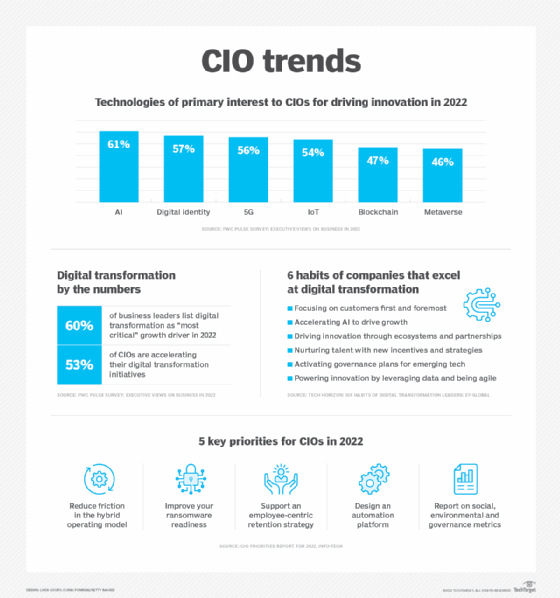5 factors reshaping the role of the CIO in 2022
The role of the CIO in 2022 is being shaped by a constellation of new technologies and the business's burning need to use them for competitive advantage.
The digital-first world that has emerged in the wake of the COVID-19 pandemic is reshaping the role of CIOs.
For Susan Snedaker, CIO at El Rio Health, a nonprofit health provider based in Tucson, Ariz., showing the business what's possible and how to achieve its goals through technology has become the cornerstone of the CIO role today.
"The CIO's role has moved from collaborative partner to strategic leader," Snedaker said, adding that there are fewer and fewer business initiatives that don't have technology at the center of the discussion. Having a strategic business thinker as the organization's top technology officer is imperative in 2022.
She sees CIOs driving business transformation through digitizing repetitive, internal-facing operational tasks and by developing innovative digital business initiatives. "The first is table stakes, the second is the source of competitive advantage," she said.
The expectation of CIO as business strategist is not the only trend defining the role in 2022, according to interviews with multiple CIOs and other enterprise IT experts. Here's a look at the five factors they see as reshaping the role of the CIO in 2022.
This article is part of
The evolving CIO role: From IT operator to business strategist
1. Business value generation
Most CEOs and C-suite executives shed their view of IT as a cost center years ago, as they came to see CIOs as enablers of business strategy. But some leading organizations go well beyond that, and even beyond considering the CIO as a business enabler, said Bobby Cameron, vice president and principal analyst at Forrester Research. These organizations view IT as an integral part of delivering value and indeed revenue to the enterprise, he said.
 Bobby Cameron
Bobby Cameron
Forrester breaks down IT maturity into three levels. The first is traditional IT, where the CIO and IT act as order takers. The next is modern IT, defining IT as a "partner player." The third and most mature is future fit IT, in which IT shares accountability for business performance.
"These CIOs have revenue ownership," Cameron said of CIOs working in future fit IT departments.
He said Forrester's research shows that organizations with future fit IT departments grow 3.5% faster than industry average. However, they remain a rare breed. He cited research showing that the majority of IT organizations (58%) are still at the first level of maturity, 38% are modern and only 3% are considered future fit. On the other hand, he said he sees more CIOs maturing their own IT organizations. "They're shifting from cost-driving to value-driven," he said.

2. Agility, innovation, transformation
PwC in its latest Pulse Survey found that 60% of the executives it surveyed listed digital transformation as their most critical growth driver in 2022.
The survey also found that 53% of CIOs are accelerating their digital transformation initiatives.
And it found that the No. 1 priority for CIOs is refining their operating model to be more agile, with 43% listing this area when asked how they'll spend their time and money in 2022.
 Dan Priest
Dan Priest
As part of all that, CIOs are focusing on how they can use a range of emerging and mature technologies to innovate and support transformation, said Dan Priest, managing partner for cloud and digital at PwC.
He pointed to other survey findings that show 61% of CIOs listing artificial intelligence as the technology of primary interest for driving innovations in 2022. Other top technologies for innovation include digital identity (57%), 5G (56%), IoT (54%), blockchain (47%) and metaverse (46%).
PwC noted in its report that each of those technologies "can underpin a company's innovation strategy" but said they're more likely to be used in combination. In fact, it's that combination, or convergence, of technologies that's most impactful, Priest said.

3. Customer centricity
According to Sumana Nallapati, global CIO at Insight Enterprises, "Customers want us to meet them in very personalized ways."
As a result, she said she considers getting to customer delight/customer obsession as a top CIO priority.
 Sumana Nallapati
Sumana Nallapati
Nallapati said she and her IT team are building data-driven operating models to reach that objective. They're creating a unified data architecture to allow for prescriptive data insights, using AI to help reduce friction in processes, and deploying more automation -- including chatbots -- to speed processes and free up "human power to truly bring value-add."
She noted that it's all part of delivering "a human-centric, customer-centric way of doing business."
Others said they share Nallapati's focus on customers -- and with good reason: Research from professional services firm EY identified six common habits among companies that excel at digital transformation, with putting the customer "first and foremost" topping the list.
IT uses technology as force multiplier in improving patient care
The IT team at El Rio Health is delivering more than technology solutions, according to CIO Susan Snedaker: They're devising initiatives that impact the quality of care provided by the Arizona-based healthcare entity.
 Susan Snedaker
Susan Snedaker
Take, for example, an ongoing IT initiative to automate repetitive electronic tasks. "We are using native automation with some of our existing solutions in tandem with a phased rollout of an RPA solution," Snedaker said, adding that "down the road, we'll look to standardize across one platform." The work will not only reduce errors and speed up processes but also free up El Rio caregivers to do interesting and innovative work.
Her team also originated a remote patient monitoring initiative that is "driving improvements in patient care using technology as a force multiplier," she said.
These projects, she noted, didn't come into IT as requests from other departments but rather were devised and developed by IT, reflecting the universal trend of IT taking a lead in business strategy.
4. Improved cybersecurity posture and ransomware readiness
Organizations across industries face an ever-expanding threat landscape, and as such CIOs can no longer afford to be reactive, said Dana Daher, research director in the CIO practice at Info-Tech Research Group.
 Dana Daher
Dana Daher
She said CIOs are being tasked with improving their organization's cybersecurity posture by acting in more proactive ways. They're now expected to address the risks they introduce when they create new products and services, such as hybrid working environments. In fact, of the five priorities Info-Tech Research Group listed as crucial for CIOs to compete in the digital economy, improving ransomware readiness came in second, after "reducing friction in the hybrid operating model."
"There is a new suite of risks emerging and CIOs have to be at a forefront of addressing them," Daher said, adding that CIOs today are more likely to collaboratively make decisions with security and risk officers as the tech stack and IT environment change and evolve.
5. A tilt to the CIO as technologist
CIOs for at least the past decade or so have had to have business knowledge, executive skills and technology skills to successfully lead their IT departments and help shape enterprise strategy together with their C-suite colleagues.
Experts stressed that CIOs still must have the business and executive components; those aren't going away or being diminished; but some are seeing a rebalancing of those three traits with the technology element gaining new emphasis.
 Benjamin Rehberg
Benjamin Rehberg
Benjamin Rehberg, managing director and senior partner with Boston Consulting Group and leader of the firm's Technology Advantage practice in North America, said he sees a renewed emphasis on CIO as a technologist.
"I think successful CIOs have become significantly more technical, and I think [the era of] CIOs not having deep technical skills is coming to an end," he said. "All the successful CIOs I know are deeply technical."
Rehberg said one factor driving this shift back to CIO as a technologist is the IT team itself. "Technologists want to be led by technologists. They want their CIO to have an appreciation for the technology," he explained.
That's not all, though.
Rehberg said the technologies driving transformation and enterprise evolution today, such as AI and blockchain, are complex and require IT executives who have more than a high-level understanding of them.
"The strategic engagement required is so profound, that if you don't understand the technology, you won't have the insights into the opportunities that the technology provides," he said, asking: "How can you explain it to someone else if you don't understand the possibilities that exist?"







